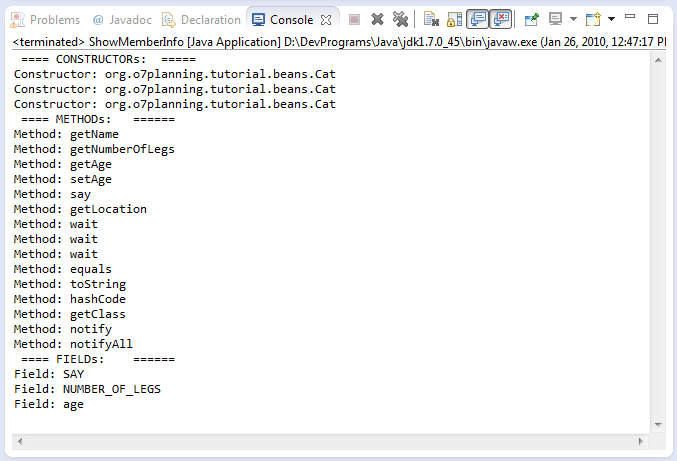

This method gets the value of a static or instance field of type double or of another primitive type convertible to type double via a widening conversion This method returns the Class object representing the class or interface that declares the field represented by this Field object This method returns annotations that are directly present on this element This method gets the value of a static or instance field of type char or of another primitive type convertible to type char via a widening conversion This method gets the value of a static or instance byte field This method gets the value of a static or instance boolean field This method returns annotations that are associated with this element


This method returns this element’s annotation for the specified type if such an annotation is present, else null. This method returns an AnnotatedType object that represents the use of a type to specify the declared type of the field represented by this Field This method compares this field against the specified object. They return an array of Field objects that provide information about the object. Once this is obtained, getFields() is used to analyze the class object. The program begins with forName() method of Class to get a class object for. The following application illustrates a simple use of java reflection. AccessibleObject, Array, Constructor, Executable, Field, Method, Modifier, Parameter, Proxy, ReflectPermission. There are also ten classes in this package i.e. Of special interest is Member which defines methods that allow getting information about a field, constructor or method of a class. The package includes several interfaces. Reflection mechanisms allow one to bypass it to some degree, and introduce some more dynamic features, like, say, retrieval of the value of the field by name. Java, like many other languages, is statically typed.
#JAVA REFLECTION GETFIELDS SOFTWARE#
Field serves the same purpose as the whole reflection mechanism, analyze a software component and describe its capabilities dynamically, at run time rather than at compile time. This is provided by the package and elements in Class. The ability of the software to analyze itself is known as Reflection. ISRO CS Syllabus for Scientist/Engineer Exam.ISRO CS Original Papers and Official Keys.GATE CS Original Papers and Official Keys.

Then if you want to instantiate class object objA you can do that using class.newInstance() method. Same way if you want Class object for ClassA. Note here that type (Boolean) is used to get instance of Class. class you can also get the Class for a primitive type.įor Example– If you want class object for type Boolean. You just need to add “.class” to the name of the type. If instance of the class is not available but the type is known, then you can get object of Class by using. Instance of Class as follows– ClassA objA = new ClassA() This methodįor Example– If you have a class called ClassA and an object objA of that class then you can get If you have an instance of the class available, then you can get Class by invoking Object.getClass() method.
#JAVA REFLECTION GETFIELDS CODE#
There are several ways to get a Class depending on whether the code has access to an object, the name of class,


 0 kommentar(er)
0 kommentar(er)
